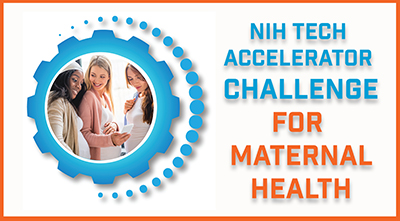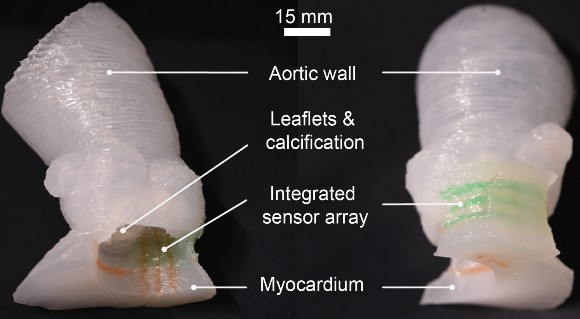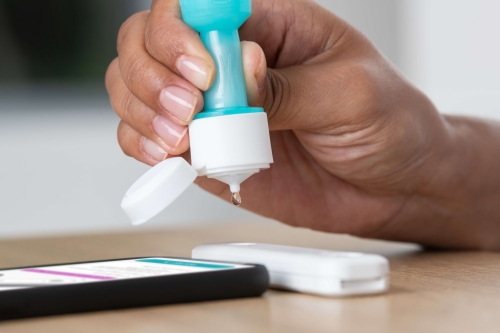The National Institutes of Health today announced the winners of its NIH Technology Accelerator Challenge (NTAC) for Maternal Health, an awards competition for developers of diagnostic technologies to help improve maternal health around the world. Complications of pregnancy and childbirth are a major global health problem. Tragically, these complications cause the death of more than 800 women and 7,000 newborns every day. Low-cost point-of-care diagnostics that can detect and differentiate between common conditions associated with pregnancy are needed to help reduce high rates of maternal morbidity and mortality in low-resource settings.
Winning technologies share a total of $1 million in awards for the successful design and development of diagnostic tests and platform technologies to reduce maternal morbidity and mortality. The award competition is managed by the National Institute of Biomedical Imaging and Bioengineering (NIBIB), in partnership with the Bill & Melinda Gates Foundation and with support from the Eunice Kennedy Shriver National Institute of Child Health and Human Development and the NIH Office of Research on Women’s Health.
“This competition prioritized technologies that could have a life-saving impact on women, families and communities, and provide healthcare workers with technologies they can easily integrate into practice with their patients,” said NIBIB Director Bruce J. Tromberg, Ph.D. “We congratulate the teams that entered this field of competition with their innovative device designs and platform technologies, as well as articulating a path for the translation and use of their innovations in global health settings.”
Priority maternal health conditions addressed in NTAC for Maternal Health include infections, hypertensive diseases, hemorrhages, and placental problems. Hemorrhage, preeclampsia and bacterial infections account for more than 50% of global maternal mortality, and 94% of these deaths occur in low- and lower-middle-income countries.
The NTAC for Maternal Health attracted more than 40 nominations, five of which were selected to receive cash prizes, while four additional nominations received honorable mentions. Each of the cash prize winners will be invited to present a summary of their diagnostic technologies in a winners’ presentation broadcast live from 2 to 3:30 pm on Thursday, August 4, 2022. Pre-register here up to one hour before the event.
The Bill & Melinda Gates Foundation will separately review winners and honorable mention recipients and consider them for follow-on support that may include grants and/or in-kind support in the form of consultations and partnerships for clinical data collection, software development, scale-up and manufacturing. Read more about the NTAC Maternal Health program.
The winning technologies are the following:
First place and prize of $500,000. Dr. Bethany Hedt-Gauthier, Harvard University, Boston. mHealth tools for home diagnosis of surgical site infections and anemia after cesarean delivery, led by community health workers. An integrated, stand-alone mobile health tool for community health workers to monitor women’s postpartum recovery after a cesarean delivery. The tool allows home diagnosis of surgical site infections and anemia. The team designed the technology to be used in rural Rwanda; Its use could be transferred to low-resource and low-infrastructure settings in other countries.
Second place and prize of $300,000. University of California, Irvine. Maternal Obstetrics Monitoring Sock (MOMS). The hemodynamic monitoring sock is a low-cost, portable point-of-care system for monitoring pregnant women for preeclampsia, anemia, and hemorrhage. Continuously tracks blood pressure and heart rate and monitors blood flow; It can be used during and after childbirth in low-resource settings.
Tie for third place and prize of $75,000. Softsonics, LLC, San Diego. A wearable ultrasonic/electrochemical sensor for maternal health monitoring. An integrated, elastic, conformal wearable sensor that provides dynamic and comprehensive monitoring of pregnancy complications, including sepsis, preeclampsia, and placental dysfunction. The sensor can monitor blood pressure, heart rate and lactate levels and can facilitate Doppler ultrasound imaging. The technology does not require a trained operator, allowing it to be used in low-resource settings.
Tie for third place and prize of $75,000. Raydiant Oximetry, Inc., San Francisco. LUMERAH™ near-infrared spectroscopy platform for diagnosing maternal hemorrhage and fetal distress during pregnancy. The LUMERAH™ system is a non-invasive platform technology that uses near-infrared spectroscopy to perform non-invasive pulse oximetry. The device is being developed for the diagnosis of fetal hypoxic distress during childbirth and maternal hemorrhage in the postpartum period. These conditions affect mothers throughout the developed and developing world.
Semifinalist and prize of $50,000. Stanford University, Stanford, California. Point-of-care diagnostic tool for preeclampsia and anemia during pregnancy. A fully integrated molecular diagnostic system on a miniaturized, disposable semiconductor chip that enables early, simple, low-cost detection of preeclampsia and maternal anemia at the point of care. The technology will identify high-risk pregnancies and allow for their close monitoring and early intervention and will be suitable for use in both high-income and low- and middle-income countries.
Honorable mention. VoluMetrix, LLC, Nashville. Non-invasive venous waveform analysis (NIVA) for maternal health. An easy-to-use, accurate, non-invasive wrist sensor for monitoring key physiological variables by capturing low-frequency venous waveforms. It is being developed to provide hemorrhage monitoring, early detection of preeclampsia, and acute respiratory distress monitoring. Ease of use and portability allow a healthcare provider to monitor a patient in the hospital or at home during the peripartum period and during delivery.
Honorable mention. Dr. Mathias Wipf, MOMM Diagnostics, Basel, Switzerland. Rapid Preeclampsia Diagnostic Test (RaPiD). A cost-effective method to rule out or diagnose preeclampsia at the point of care using an easy-to-use blood test. This proof-of-concept prototype for a rapid preeclampsia diagnostic test determines the concentration relationship between two preeclampsia biomarkers from a single drop of blood. It offers a low-cost solution for immediate and continuous monitoring of the patient during pregnancy checks.
Honorable mention. Purdue University, West Lafayette, Indiana. Modify the maternal recumbent position to prevent preeclampsia and placental disease. The automated supine pressor test (Auto-SPT) is an adaptation of the supine pressor test used to predict the risk of preeclampsia in pregnant women based on the elevation of their diastolic blood pressure when shifted from the left side to the back. Auto-SPT uses a standard brachial blood pressure cuff, smartphone, and position sensor to guide patients through the test. Auto-SPT is primarily designed to be used at home to predict the risk of preeclampsia or to position oneself therapeutically to reduce placental disease.
Honorable mention. Washington University in St. Louis. Maternal armor: Preventing global maternal mortality and morbidity with a wearable device. A low-cost, wearable device that provides real-time data to inform early clinical decision making for hemorrhage and preeclampsia in high- and low-resource settings. Maternal aRMOR uses a low-power laser and light sensor to monitor physiological changes that can be used to diagnose hemorrhage and preeclampsia. The device, which can be used during pregnancy, childbirth and postpartum recovery, interacts with a mobile phone or tablet and provides actionable results in minutes.
###
About the National Institute of Biomedical Imaging and Bioengineering (NIBIB): NIBIB’s mission is to improve health by leading the development and accelerating the application of biomedical technologies. The Institute is committed to integrating engineering and physical sciences with biology and medicine to advance our understanding of diseases and their prevention, detection, diagnosis and treatment. NIBIB supports research and development of emerging technologies within its internal laboratories and through grants, collaborations and training. More information is available on the NIBIB website.
About the Eunice Kennedy Shriver National Institute of Child Health and Human Development (NICHD): The NICHD leads research and training to understand human development, improve reproductive health, improve the lives of children and adolescents, and optimize the capabilities of all. For more information, visit https://www.nichd.nih.gov.
About the Office of Research on Women’s Health (ORWH): ORWH serves as a focal point for women’s health research at the NIH. It is the first Public Health Service office specifically dedicated to advancing women’s health research within and outside the NIH scientific community. The office also encourages the recruitment, retention, reentry and advancement of women in biomedical careers. For more information about ORWH, visit www.nih.gov/women
About the National Institutes of Health (NIH): The National Institutes of Health, the nation’s medical research agency, includes 27 institutes and centers and is a component of the U.S. Department of Health and Human Services. The NIH is the primary federal agency that conducts and supports basic, clinical, and translational medical research, and is investigating the causes, treatments, and cures of common and rare diseases. For more information about the NIH and its programs, visit the NIH website.



